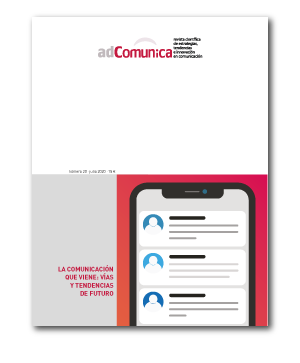Imagen y título de portada como elementos estratégicos de comunicación política en YouTube: uso por parte de la esfera política española
Contenido principal del artículo
Resumen
Los partidos políticos tienen cada vez más presencia en redes sociales. Sin embargo, las estrategias comunicativas en estas difieren de las desarrolladas en medios convencionales. El entorno digital multiplica el número de actores que intervienen en la construcción de la información política, lo que incide de manera directa en la imagen que, en este tipo de espacios, se proyecta de los representantes públicos y sus formaciones. El mensaje planificado por la esfera política compite en este escenario con infinidad de prosumidores que dificultan obtener la eficacia estratégica deseada. Esta investigación examina cómo gestionan los partidos políticos españoles las peculiaridades de producción y difusión de contenidos en YouTube a través de tres elementos: el canal desde el que se publican los vídeos, la imagen de portada que encabeza los contenidos y los títulos que la acompañan. A nivel metodológico se adopta una perspectiva cuantitativa-cualitativa. Mediante análisis de contenido se examinan un centenar de vídeos de entre los más reproducidos en 2019 sobre los cinco partidos políticos españoles de ámbito estatal con mayor representación parlamentaria. Entre los resultados destaca el escaso control de la esfera política en los contenidos publicados, cuya gestión comparte con la esfera pública y la mediática, casi a partes iguales. Al margen de la falta de intervención generalizada por parte de los partidos políticos en los contenidos que sobre ellos se difunden y consumen en YouTube, los datos posicionan a Vox como la formación que ejerce una gestión más directa sobre los indicadores examinados.
Descargas
Detalles del artículo
1. Política propuesta para Revistas que ofrecen Acceso Abierto
Los autores que publican en esta revista están de acuerdo con los siguientes términos:
- Los autores conservan los derechos de autor y garantizan a la revista el derecho de ser la primera publicación del trabajo al igual que licenciado bajo la licencia CC BY-SA, que permite a otros compartir el trabajo con un reconocimiento de la autoría del trabajo y la publicación inicial en esta revista.
- Los autores pueden establecer por separado acuerdos adicionales para la distribución no exclusiva de la versión de la obra publicada en la revista (por ejemplo, situarlo en un repositorio institucional o publicarlo en un libro), con un reconocimiento de su publicación inicial en esta revista.


